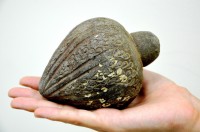The hand grenade is a handsome example of a weapon in common use by Islamic forces during the Crusader (1099-1187), Ayyubid (1187-1250) and Mamluk (1260-1516) periods. It is made of unglazed ceramic and embossed with grooves and tear drop-shaped designs. It has a domed top over a spherical body that tapers to a point. They were filled with incendiary material – petroleum, naphtha, Greek fire — and thrown or catapulted into the enemy camp where they exploded fire that water could not put out on their targets. There’s a small hole in the top into which flammable liquid could be poured and a wick added once the grenade was loaded.
Some scholars believe these vessels were not weapons, but rather perfume bottles. They’re certainly pretty enough for it and it seems counterintuitive that someone would bother to decorate an explosive projectile whose sole function is to destroy itself and take people down with it. On the other hand, their shape makes them markedly unsuited for placement on a dresser, requiring a rack or holder to keep them vertical, and the decorations also have the practical function of making the devices easier to grip in the hand or set snugly in the sling of a catapult. A smooth clay grenade would be dangerously easy to drop.
 There is historical and archaeological evidence of this type of vessel being used in war. For one thing, clusters of them have been found in fortresses, castles and moats. The 12th century historian Mardi ibn Ali al-Tarsusi mentioned in the military manual he wrote for Saladin in 1187 that terracotta vessels with incendiary contents were launched from catapults or thrown from ramparts. Other sources from the 12th, 13th and 14th centuries describe the clay gourds in more detail, explaining how they were used in battle and the various launching methods. Chemical analysis of residue inside several similar pieces discovered traces of rock salt, pine resin and other flammable materials. One gourd on display in the National Museum of Damascus has an inscription that leaves no question as to its bellicose purpose: “This kind of projectile is useful for targeting the enemy.”
There is historical and archaeological evidence of this type of vessel being used in war. For one thing, clusters of them have been found in fortresses, castles and moats. The 12th century historian Mardi ibn Ali al-Tarsusi mentioned in the military manual he wrote for Saladin in 1187 that terracotta vessels with incendiary contents were launched from catapults or thrown from ramparts. Other sources from the 12th, 13th and 14th centuries describe the clay gourds in more detail, explaining how they were used in battle and the various launching methods. Chemical analysis of residue inside several similar pieces discovered traces of rock salt, pine resin and other flammable materials. One gourd on display in the National Museum of Damascus has an inscription that leaves no question as to its bellicose purpose: “This kind of projectile is useful for targeting the enemy.”
The IAA is grateful that the family has voluntarily come forward and handed the artifacts over to the state. Officials plan to give the Mazliah family with a certificate of appreciation and, which is way cooler, have invited the family to visit the IAA laboratories where the artifacts will be studied and conserved.
